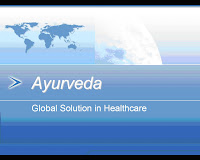Global Scenario of Ayurveda
• Australia: Australian Traditional Medicine Society (ATMS) is the authority. Australian Association of Ayurveda, Adelaide and SA.
• Russia: Russian Government has recognized Ayurveda as potential system of medicine. NAAMI Ayurveda Medical Centre is a success. Recognized Panchakarma & Ksharasutra.
• Srilanka: Separate National Health Policy for Ayurveda. Qualified practitioners. Ayurveda Universities award BAMS degree.
• Nepal: Govt. recognized Ayurvedic system and has National policy. Recognized degree course in Tribhuvan University Kathmandu.
• Bangladesh: Ayurveda is practiced and taught legally. 5½ years’ graduation course in Dhaka University.
• USA: 47% of the population restored to alternative medicine and amongst them Ayurveda is highly preferred. Medicines used as dietary supplements. California college of Ayurveda- 2 yrs course and recognized officially to practice. In Florida, New Mexico, New York- recognized as herbal practitioners.
• UK / EU countries: Around 150 Ayurvedic doctors are practicing. 2 Ayurveda colleges in London offer BA (Hons.)- 3 years, 1000 hrs classes. Govt. is still hostile to recognize.
• Argentina, Brazil, Republic of Czechoslovakia, Greece, Israel, Netherlands etc- Ayurveda is coming up recently. Graduates of Medicine have PG course to learn the basics of Ayurveda.
• Australia & New Zealand: New Zealand is liberal. Australia is forming laws. The National Academy of Natural Medicine offers diploma in Ayurveda after 4 year medicine course.
• Germany: Greatly aware of Ayurveda. Not allowing to practice. But German doctors are prescribing Ayurvedic medicines and practice Panchakarma after trained in India.
• Italy: The Instituto Italiano di Ayurveda is disseminating the ideals of Ayurveda. But export of medicines and practice is not easy yet.
• Japan: Study, research and practice since 30 years. In 1969, Prof.Hiroshi Maruyama of Osaka Medical College established Society of Ayurveda. The Institute of Traditional Oriental Medicine in Tokyo offers short term Ayurveda course
• Mauritius: Government has recognized and sends students to India to learn Ayurveda.
• Sultanate of Oman: An Ayurveda doctor treated the Sultan of Oman. Being surprised by the efficacy of Ayurveda, the Sultan recognized the system and gave approval for the system. Qualified Ayurveda doctors can practice after passing the local entrance test.
• Hungary: Only European country, which has recognized Ayurveda as medical system. Practitioners are less. But, many foundations and centers are coming up.
• South Africa: Recognized as alternative system of medicine. Has a representation in South African Ayurveda Liaison Committee and also the African Allied Health Professional Act. Many medicines are also exported.
[Based on the information in Ayurvedline, a leading Ayurvedic Therapeutic Index.]


























